February 21, 2022
11:33 am
Podcast Response: Judaism Unbound #313 - Learning, Unlearning and . . . onion learning?
Hosts: Dan Libenson and Lex Rofeberg
Guests: Tova Birnbaum and Kershia haLev Fife
Introduction: I spend a lot of time listening to podcasts each week. I do it partially to kill time (podcasts make housework much more tolerable — especially dealing with dishes and laundry, but also can make long boring stretches of a bike ride more pleasant), but mostly for inspiration and education.
On a couple of these podcasts (including the one I'm review here), I've heard a phrase that has stuck with me: “this too is Torah.” Taken to its furthest extent (as Judaism Unbound already did in episode #309), there is no reason why podcasts, blog posts, and even social media memes might legitimately be considered Torah (in the broader sense of the word), and even might someday be considered to be part of a canon in the future.
Of course Torah always involves diaglogue and even argument (which is why we see so many contradictory positions taken in the Bible and in the Talmud)... and so in my tiny way, on this obscure blog with few readers, I’m going to throw my bit of reflection, response, argument into this swirling dance. I hope you, the reader, will do your part and add your own voice too.
And so this brings me to the latest podcast I've heard from Judaism Unbound, episode #313.
In this episode, show hosts Dan & Lex are joined by Tova Birnbaum and Keshira haLev Fife for their first “faculty meeting” of sorts, of the UnYeshiva, an online educational initiative that was launched in the fall by Judaism UnBound. I personally was excited to listen to this episode as I’m enrolled in one of these classes (set to start on Thursday!), and I was not disappointed.

Here are few highlights that stood out to me:
- There was quite a bit of discussion about the wonders of online community and learning, and how this new yeshiva (normally a very local learning experience) is happening in a very international way with the teachers being physically present in 4 locales (Chicago, Israel, Rhode Island and Pittsburgh) with students in many other locations.
- I was moved by Keshira’s remarks (around 20:04) about Jews needing to awaken to the idea that we are not only “people of the book” but also are people of the earth, and people of the body.
- Tova’s critique (starting around 27:33) of the idea of sequentially structured learning (that one must learn A, before moving onto B) seems very important to me, and reminds me of conversations I’ve had in the homeschooling world with home educators who are hyper-focused on the idea that one must teach all of the foundational facts before moving on to doing critical thinking — a view that I do not agree with. While I certainly understand the value of context for learning, I don’t see any good reason to ever forbid learning on new topics or to engage in critical thinking.
- Dan’s remarks (starting around 32:40) about wanting the UnYeshiva experience to be like art school made me smile, in part due to the current media buzz (see NY Times: Art School Looked Like a Lot of Fun In the ’90s --- A homage to a predigital era has popped up, as a crowdsourced art project that lives, paradoxically, on Instagram.) about the 90ArtSchool Instagram feed.
- Dan unpacked the “this too is Torah” remark some more (around 50:03), with a rather disturbing and humorous Talmudic story.
- Kershira’s remarks about not staying too focused on texts (starting around 54:29), but instead to seeking to move towards experiential deep learning that flows from one’s own experiences with the earth and with the body were divine!
So that’s my response to episode #313 of Judaism Unbound. I hope to share more posts like this in the coming days.
February 19, 2022
12:20 pm - Why I quit driving (most of the time) for Shmita

In the summer of 2021, I got hooked on the Judaism Unbound podcast.
The podcast pulled me in because of its philosophy (seeking to unbind Judaism from those traditions and practices that have not served it well), its educated thoughtfulness, the insatiable curiosity of the show’s hosts, and of course the wide range of interesting topics discussed.
One of those interesting topics was the concept of the 7-year cycle of the Shmita year, which is rooted in the Jewish Biblical tradition of Shmita taken from the following texts: Exodus 23:10-11, Leviticus 25:2-7, 20-22, and Deuteronomy 15:1-3. The tradition was also further expounded in the Mishnah and the Jerusalem Talmud (tractate Shevi’it).
The very abbreviated version of a very large tradition is as follows: Shmita is a 7-year sabbatical cycle for the land, in which most agricultural activities are suspended and the land is allowed to lie fallow, while at the same time the human community is transformed through the forgiveness of debts owed in the context of the community. In practical terms, Sh’mita has largely been ignored by diasporic Jews until recently, mostly due to: (1) the traditional idea that the agriculture-based mitzvot (commandments or teachings) of Sh’mita can only be performed in Eretz Israel (the land of Israel), and (2) the perceived impracticality of practicing widespread debt forgiveness.
Listening to Episode #287 of Judaism Unbound (The Shmita Project) was my first real introduction to the idea of modern Jewish reinvention of Shmita, which led me to their other episodes on the theme of Shmita, and finally a big question: what would I do to make the upcoming Shmita year special, since it had only recently begun on Rosh Hashanah of 2021.

Before I go on, I should mention that as a Humanistic Jew, I don’t see mitzvot as binding commandments from God, but rather them as human teachings developed in the Jewish community over time (and that can be changed or even discarded over time), which means that I think that Shmita, like all of the mitzvot, will only have the life that we as humans breath into it. Thankfully, I find the themes of Shmita (environmental and economic sustainability) as being incredibly relevant for our day, so this seems like a type of practice that is desperately needing a revitalization and/or a reboot.
And so I considered many options on ways to take the Shmita concept and apply it in my life (or in the communities, I am a part of - family, synagogue, etc. (here’s a link to a blog post from back in October where I talked about this earlier) And then it hit me . . . changing how I do my personal transportation would be the best thing I could do to observe Shmita, since it was something I actually had the means to do something about.
The means had come by way of a delivery truck that stopped at our house in the middle of the High Holidays — an e-bicycle that I had ordered. I had long wanted to get one (after I got to ride one for the first time near Cabo San Lucas, Mexico) but finally the prices dropped enough that I decided to not wait any longer.
And in my early days with the e-bike, I rode it all that I could, being amazed by the ways that an electric motor seemed to magically make bearable the long boring stretches of riding I often had to do in suburbia. It felt like those magical joyful moments of childhood on a bike. And so I found every way possible to get around by bike, just because I liked it.
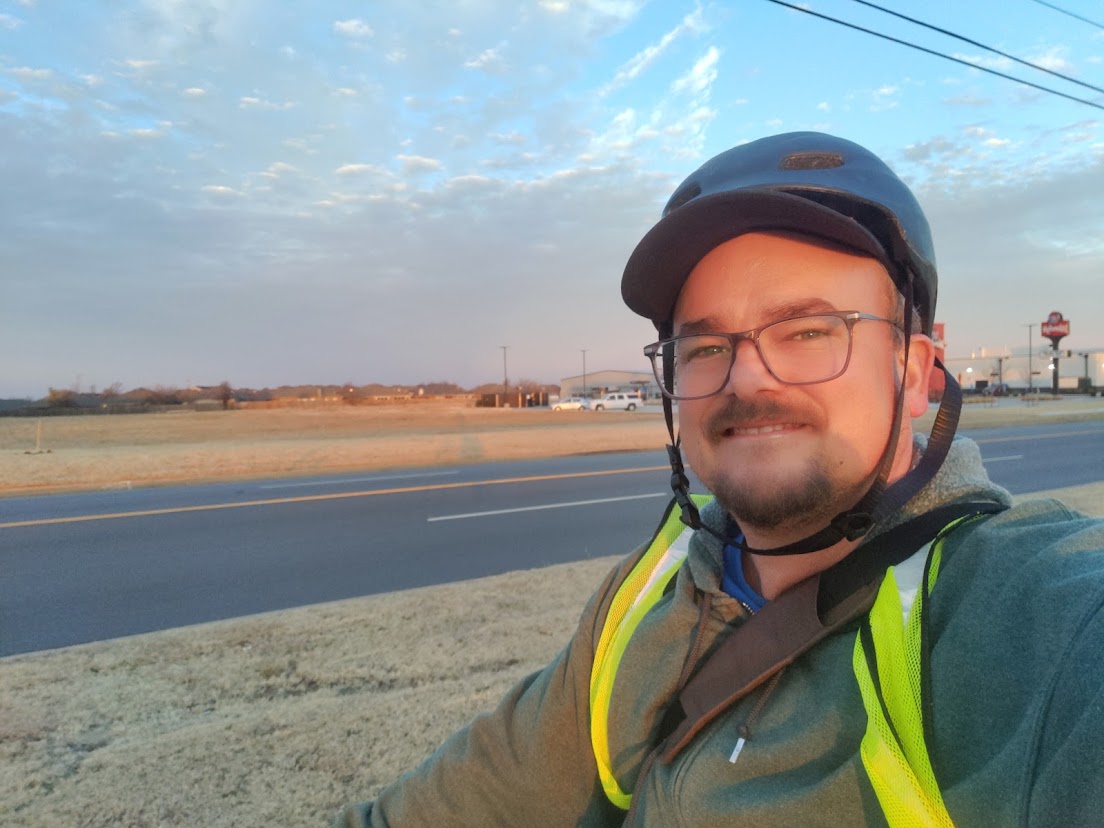
I don’t remember the magic moment that I realized that not driving would be the best way I could observe Shmita, but rather I think it was a gradual kind of realization, probably made while listening to Judaism Unbound while on the bike.
The benefits of this practice became quickly obvious:
- Environmental benefits - Driving a gas-powered car means putting greenhouse emissions in the air. It also means that I’m contributing to the war economy, since so many of our wars are fueled by our society’s insatiable need for oil. --- Electric vehicles are not a cure-all for carbon emissions (due to the use of dirty fuel for much electrical generations), however in my case it comes close to it, as our household paid extra to get 100% wind power from our electrical company.
- Frugality - I previously did the math on this for this blog and discovered that the e-bike’s cost (in fuel and batteries — because batteries do not last forever) is about 4 cents per mile, as compared to my car’s cost (in fuel) was 14 cents per mile. --- Of course this doesn't factor in all costs for cars (including insurance) or e-bikes (I ended up buying a second one to have one to ride while waiting for a warranty repair to be done --- but I also have had to invest in warm weather gear, reflective safety vests, etc.), but it still isn't a bad starting place for consideration.
- Solidarity with the poor - This value became important to me in my pre-Jewish days (thanks to the influence of my Mennonite mentors, Moses and Sadie Mast), but it has come back to me in the principles of Shmita, since the experience of not driving is an experience that few who are not in poverty experience in Oklahoma City. This helps me to know the state of our city's sidewalks in different locales, where the bus stops are at, etc.
- Time for Self-Education - Time on the bike has given me more time to listen to podcasts and audiobooks. Of course I could listen to those things in the car too, but there was less time to do so and often I was too distracted by driving to be able to listen. In fact, I am convinced that my imagination is much more expansive when I’m on the bike.
- Health - While the ebike is not as much exercise as a regular non-motorized bicycle, it is a vehicle that I am much more likely to ride every day, and hence I think I get more total exercise on it.
- Happiness - While I can’t quantify this, I can tell that my challenges with depression and anxiety are much reduced on days that I spend time on the bike.
- Spirituality and wonder - I can’t help but feel a deep sense of awe when I’m out on the bike and get to see an exquisite sunset, or I see a flock of geese fly over my head on their way to the pond where they can plan to spend the night. Moments like these put the difficult parts of my life in perspective and make me feel connected with the universe.
- Meaning - Like many in our modern society, it is easy to feel like our lives lack meaning. This practice transforms something mundane (getting from point A to point B) into a practice tied to my Judaism, and hence connects it to the great tradition going back to our sacred mythologies. This realization is inspiring to me and helps me to press forward on the bad weather days.
Before long though, my gradual realization felt more and more like an ongoing commitment (and one that sometimes necessitated to the kind cooperation of my family), which necessitated me coming up with some rules for this practice (because that's what Jews do). This is what I came up with:
- On any personal errands (where it is just me traveling), I will do my best to not drive, but instead will walk, bike, e-bike or take public transportation.
- If the needs of my family (or someone else I have an obligation to) require it, I will drive.
- If practical circumstances make cycling difficult to deal with a situation (such as the need to carry cargo that I can’t deal with on the bike or extreme weather conditions), I will do my best to drive as few miles as possible and to consolidate trips.

- Car batteries run down when cars aren’t driven every once in awhile, so I do try to drive my car a few miles every month no matter what.
So far, these rules have worked well, but admittedly my current life situation is relatively accommodating to this (I mostly work from home). This is why I don’t think that my choice is necessarily a choice that most people in my community can make. But I am hopeful that what I’m doing might help others to consider choices that are practical for them to take, such as picking one day per week to commute to work by bike or bus, but also to consider compromise improvements — such as in my case, getting an e-bike to deal with the challenges of where I live.
And while I initially envisioned this as just a Shmita thing (which will end at the start of Rosh Hashanah this year, sunset on September 25, 2022), it is more and more looking like this may become a permanent part of my life. Sometimes doing this is a hassle, but most of the time I just don’t want to go back to how life was before. But time will tell.
And lastly, for anyone interested in the practical side of e-bikes, here is some information on the two e-bikes I now have:
February 11, 2022
1:12 pm
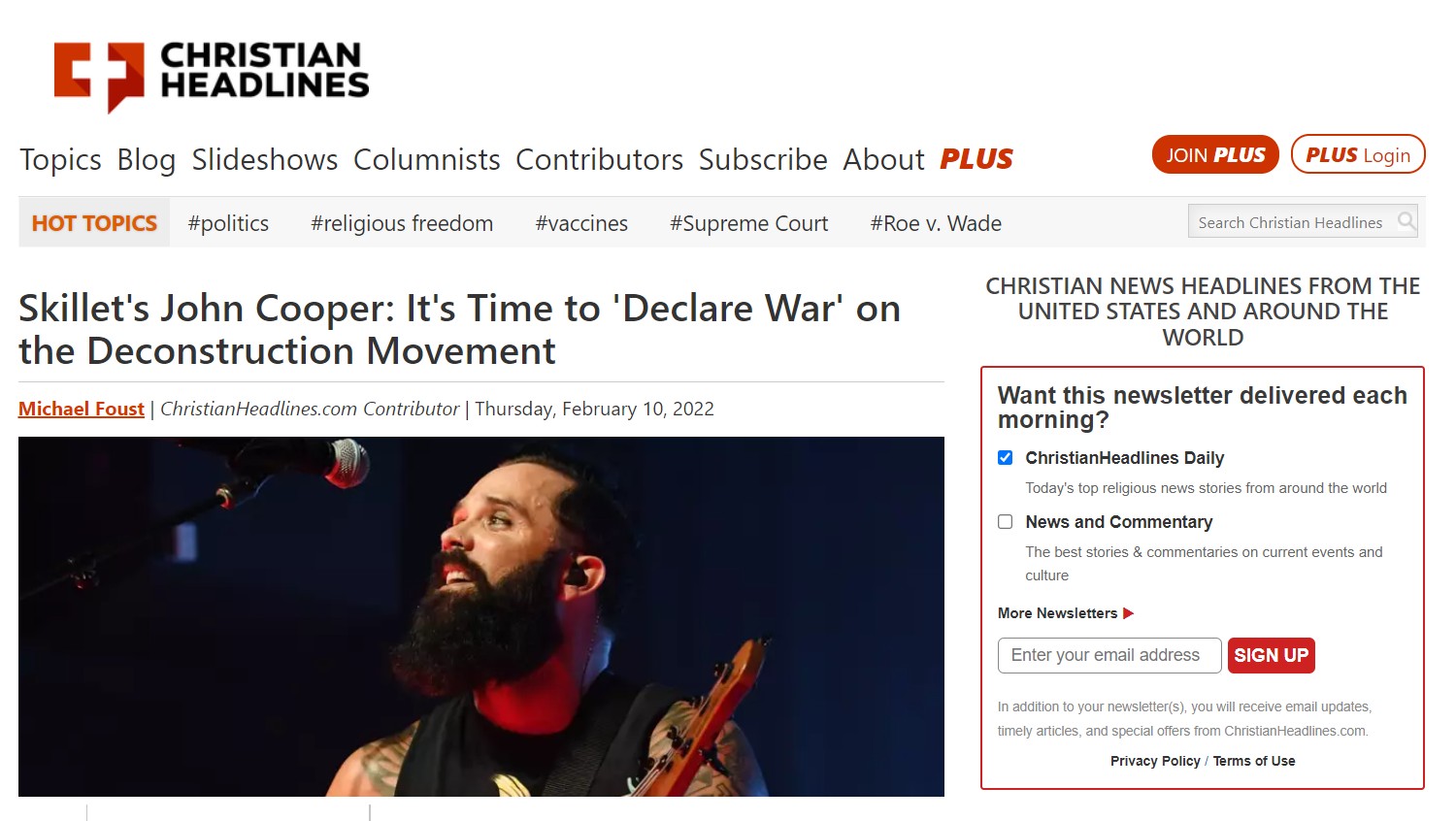
Skillet's John Cooper says it's time for Christians to "declare war" on the deconstruction movement and teach the younger generation about the "basic principles" of the faith, saying the church has done a poor job of discipleship.
Cooper did not mention anyone by name but said his comments were referencing those who "used to be Christians" but now "reject true Christianity." Several prominent singers and authors in recent years have said they've left Christianity.
..."There is no such thing as divorcing Jesus Christ from the Bible. That is not a thing," Cooper said, addressing the young people in the audience. "I don't hate those deconstructed Christians. I pray for their repentance. But listen, they have divorced themselves from God, and they want to take as many of you people as they can. And it is time for us and your generation to declare war on this idolatrous deconstruction Christian movement."
God's Word, Cooper added, "never changes."
A few thoughts in response to Cooper...
- Verbiage like "declaring war" on a movement is ridiculously hyperbolic, but also arguably dangerous, because this kind of language can provide philosophical justification to those who want to use violence against their theological opponents.
- When Cooper uses the word "Bible," he never explains what he means. Is he referring to the Jewish scriptures that Jesus frequently quoted? Is he referring to the Christian scriptures that Jesus didn't write, and never read?
- If Cooper is using the phrase "God's word"to refer to the Bible, then he is very ignorant about the subject he is speaking. The "Bible" has changed many, many times. The Jewish tradition's definition of the canon is different than that of Christianity, and Christians disagree about it too with Protestants, Roman Catholics, Orthodox, and Latter Day Saints all disagreeing on the canon. And let's talk about the text itself --- the Bible (depending on whose canon one uses) has many, many variant readings, scribal errors and outright editorial additions.
- If Cooper wants to look at why people are leaving Christianity, he needs to look at the state of US American imperial Christianity itself. Ask why so many Christians were willing to sell out their most basic of values for the sake of political supremacy? And why are so many Christians among the meanest, most hateful people in our society? --- Of course there are many good Christians out there who have not sold their souls for power and money, but they are the minority.
- Instead of declaring war against a movement (and having to say disclaimers like "I don't hate those deconstructed Christians. I pray for their repentance..."), maybe it's time to instead LISTEN to what you are saying through the ears of the other, because this rhetoric sounds an awful lot like the rhetoric used against LGBTQ people ("love the sinner, hate the sin") that all too often leads to outright hate and violence.
- Whenever I hear someone say "I don't hate..." what I'm hearing is "I'm scared of these people, so scared that I want to go out of my way to other them."
February 7, 2022
2:42 pm
KFOR.com: OKC toddler out of ICU after nearly month-long COVID-19 battle
Stories like this are a big part of the reason that my family is very vigilant about covid precautions.
12:23 pm
Village Voice Exploring the Marvelous Manhattan of Mrs. Maisel
1:00 am

Amen.
Also... just because one doesn't have racist intent, doesn't mean that one's actions end up having racist impacts.
20+ years ago I bought the lies about the Civil War being about "state's rights" and said a lot of thoughtless things, especially about the Confederate flag. --- My intent in those days wasn't racist, but my actions were, and I've spent a long time trying to undo that harm.
For anyone out there struggling with this issue, I urge you to take the advice of the OP here --- let the flag go. Flags are always problematic, but this one has an especially bad history (and I'm not just talking about the Civil War itself, but rather its use for a long time by white supremacists as a way of communicating intimidation to non-white/non-Christian people). And whatever you might think the flag means, I can tell you that it means something very different to Black people.
And by the way --- since I'm in Oklahoma, I need to say this. Just because one is indigenous, it doesn't give you an excuse to flag the Confederate flag either. But I see it all of the time on bumper stickers on cars with tribal license plates. It is such a shameful thing to see.
But going back to the issue of culture --- warts and all, culture is important. Giving up the flag doesn't mean giving up on the parts of Southern culture that are good. Our love of food and music comes especially to mind.
But it is time to ditch the flag.
Sunday, February 6, 2022
I've been continuing to make slow progress on my conversion of my old blog posts from a wordpress installation to a static html site. I'm taking it a month at a time, and adding some notes, annotations and occasionally relevant links and pictures (but all marked so the reader know what was written now, and what was written 20 years ago)
So... here are my posts from August 2002, personallly noteworthy for me as this is when I started law school.

Saturday, February 5, 2022
NPR: These eye-popping, hand-painted trucks rule Pakistan's roads - by Hannah Bloch
Friday, February 4, 2022
6:35 pm
I'm trying hard not to be hyperbolic, but news like this makes it hard not to be.
My message to my many conservative friends and family members (and yes, I have many of them, who I try hard to stay in civil communication with, even if we mostly don't talk about politics these days) need to find a few political party, because the RNC has crossed its last line of decency, by refusing to call out the January 6 rioters for what they were doing --- attempting to overthrow an election.
I am not happy to say this.
I used to be a Republican (even a delegate to the state conventions in Oklahoma and Texas in the 1990's, and if I remember state secretary of the college Republicans, I think in 1996-1997?) but left in 2000 due to a growing conflict of my own growing realization of my conscience about war and violence. Since then, my views on many subjects have continued to evolve, but I have tried to maintain a certain degree of respect for many of the old-school Republicans who were reasonable fiscal conservatives, and who wanted to ensure their voices were heard in opposition to not only their traditional opponents (liberals) but also the extremists who have been taking over their party. I obviously disagree with those old-school Republicans on a lot of issues, but I also understood them to be moderating presence and worthy debate partners.
I still believe that politics works best when different positions are rigorously and thoughtfully debated, but that isn't possible when one party has adopted an anti-democratic/pro-fascist agenda.
Personally I hope that Cheney and Kinzlinger leave the GOP, but not become Democrats.
12:00 pm
Reflections on Torah Portion TerumahEarlier in this Jewish year, I was trying to write a commentary on each Torah portion each week, but I wasn't able to keep it up past 6 or so weeks in due to the over-busyness of life.
I have still tried though to keep reading and engaging with the weekly Torah portion, so I thought this morning I would write a short blog post with some reflections on this passage. This won't be a full-blown commentary, but rather a d'rash type of thing.
Terumah starts in Exodus 25 (transation is New JPS, emphasis added is my own)
1 The LORD spoke to Moses, saying:
2 Tell the Israelite people to bring Me gifts; you shall accept gifts for Me from every person whose heart so moves him.
3 And these are the gifts that you shall accept from them: gold, silver, and copper;
4 blue, purple, and crimson yarns, fine linen, goats’ hair;
. . . 8 And let them make Me a sanctuary that I may dwell among them.
9 Exactly as I show you—the pattern of the Tabernacle and the pattern of all its furnishings— so shall you make it.
10 They shall make an ark of acacia wood, two and a half cubits long, a cubit and a half wide, and a cubit and a half high.
. . . 16 And deposit in the Ark [the tablets of] the Pact which I will give you.
. . . 22 There I will meet with you, and I will impart to you—from above the cover, from between the two cherubim that are on top of the Ark of the Pact—all that I will command you concerning the Israelite people. . .
And these divine design instructions continue from there, in a fair amount of detail.
This kind of passage is one that tended to make my eyes glaze over as a kid. I grew up in a conservative evangelical Christian tradition (the acapella-only branch of the Churches of Christ) and hence I was taught a complicated way of engaging with scripture: (1) that any events depicted, literally happened in the way the text describes it, and (2) that the priorities set by God in texts from the "Old Testament" (what I would call today the Hebrew scriptures or Tanakh) are not the same ones set by God in the New Testament.
Consequently, when I was taught texts like this one, we mostly tended to focus on the idea that the point of the tabernacle was all about the Israelites being forced to show their obedience to God, following the design instructions (dictated from on high), and that there was no real relevance of these text for any other reasons besides this, except possibly to remind modern Christians of "how much better off we are today to not have to worship in a place like this."
As I got older and questioned many of the teachings I grew up with (moving in time towards a more moderate form of evangelicalism, and later towards the liberal side of the Anabaptist/Mennonite tradition), but largely continued to have a negative view of these kinds of texts and religious architecture in general, believing that the primary concern of religous architecture should be rooted in frutality and utilitarianism, as every dollar spent on ornamanting a fancy building is a dollar not spent on caring for the poor.
Today, as a Humanistic Jew, my take on this text is quite different. I still value frugality and utility, but I also have come to appreciate the ways that our physical space for worship and community can shape us in positive ways, and hence appreciate other aspects of this text besides the principle of "obedience."
Thankfully, I think there are three big clues in this text that can help clarify this:
- Verse 2 - "Tell the Israelite people to bring Me gifts; you shall accept gifts for Me from every person whose heart so moves him." - This verse is odd in that it does beging with a commmand to Moses ("tell...") but then adds that the gifts to be accepted should come from people whose heart was moved. In other words, God(* is telling Moses to kick off a voluntary fundraising campaign to build a new place for worship.
- Verse 8 - "And let them make me a sanctuary that I may dwell with them" - This text comes from that point in time of early Jewish history where the transition to later ideas of monotheism was still being fleshed out, so the need for a dwelling place for their deity (like all of their neighbors had) was a given --- what is different though is that the Exodus account provides for a portable sanctuary, to serve a portable deity.
- Verse 22 - "There I will meet with you, and I will impart to you—from above the cover, from between the two cherubim that are on top of the Ark of the Pact—all that I will command you concerning the Israelite people." - The claim of verse 8 is made even more tangible. Not only will their deity be "living" in this tabernacle, but the deity will actually be "meeting" with "you" (Moses, the priests, the peoiple?) from the Ark of the Pact (aka, "Ark of the Covenant")
Our world is very different from the ancient world that this text came from. Religious people of most traditions do not believe that the presence of their deity(ies) in the world hinges on having a physical space of worship, yet most traditions still use religious architecture as a means to help people connect with the divine.
Sometimes this architecture is grandiose and ornate (I'm thinking of the times I've visited Eastern Orthodox Churches, but also of the pictures I've seen of the Vatican).
Other times this architecture is simple and understated (I'm thinking of my visits to a local Mosque).
Sometimes the architecture is confidentally modern (I'm thinking of the typical mega-church architecture style that blends elements of traditional protestant church buildings with a modern shopping mall).
At other times the architecture is comfortable and cozy (I'm thinking of my old Mennonite church, that met in a 100 year old house, which was first bought to house conscientious objectors during the Vietnam war era).
And some religious architecture is quite spartan --- I'm thinking of both Quaker meeting houses, but also the "auditoriums" of the Churches of Christ that I grew up in) with little if any religious imagery.
Each of these styles of buildings reflect the theological and sociological concerns of their communities.
In a Jewish context, I think the issue of physical space tends to focus on two dynamics: (1) using space as a way to promote connection with the divine (through symbolic elements --- the ark for the Torah scroll, the eternal frame, the 10 commandments being on the wall, the bimah to "go up to," and a Menorah, and (2) using space as place for community gathering including for education, socialising, celebrating, organizing and even recreating.
But also in a Jewish context, the emphasis in our modern day is focused much more squarely on the needs of our human community. With the exception of the modern state of Israel, synagogues and other Jewish spaces are normally built with voluntarily-given funds, and hence must meet the needs of the community.
I have come to appreciate this part of Judaism, especially as I've had the chance to travel to a few synaguges in other parts of the world, so I wanted to close by share some pictures of 3 synaogues that I've had the chance to visit.
Havana, Cuba - December 2019
Templo Bet Shalom - Gran Sinagogoa de la Comunidad Hebrea de Cuba (Temple Beth Shalom - Grand Synagogue of the Hebrew Community of Cuba)
I got to visit this synagogue in December 2019, shortly before the start of the COVID pandemic. I came to deliver some medical supplies (mostly OTC medications that are difficult to get in Cuba, thanks to the US government's immoral sanctions against the people of Cuba, but also because I wanted to visit this synagogue.
On my tour of the facility, I got to see the community center (the Patronato) downstairs, but also I got to see the main sanctuary, which had a very mid-century Reform temple vibe to it, which makes sense as the building was built in 1952 (7 years before the Cuban revolution).
The Jewish community has a long and complicated history with the Cuban revolution. In my conversations with members and volunteers (I speak a little Spanish, they spoke a little English, so obviously some probably got lost in translation), I heard some expression of pain from the loss of so many members of the Jewish community over the decades (a large percentage, especially of the wealthier classes) have left Cuba to go to either the USA or Israel, but also a great sense of pride over the congregation's continued presence in Cuba, their growth in recent years, and the deeper level of support for religious liberty in Cuba in recent decades (Fidel Castro's visit to the synaogue for a Hanukkah celebration in the late 90's was a particular source of pride). The congregation was also very proud of the pictures of Steven Spielberg's visit to the community, which includes a note he wrote when he was there.
The physical space is a mark of pride for this community and is being used in many ways. Like much of Cuba (including the cars and architecture), parts of the structure feel stuck in the 1950's, but other parts are showing the continual evolution of Cuban society.


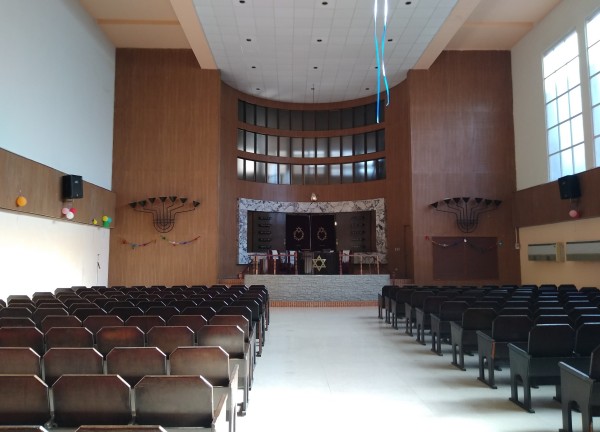
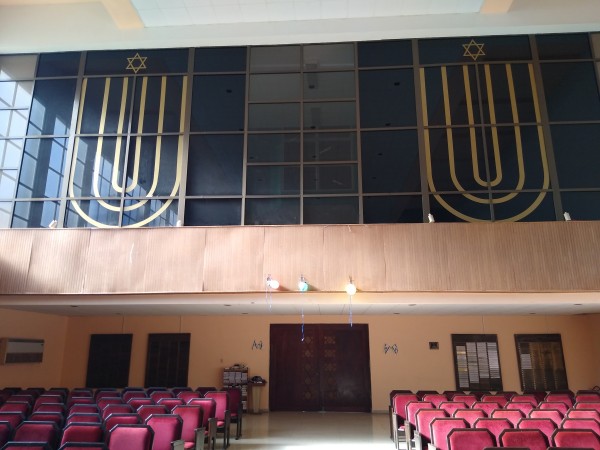
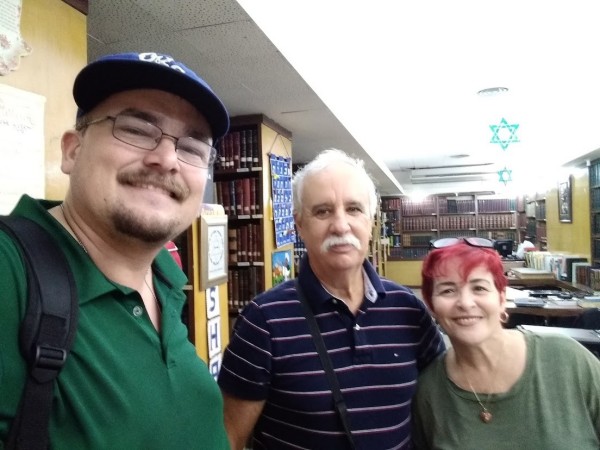

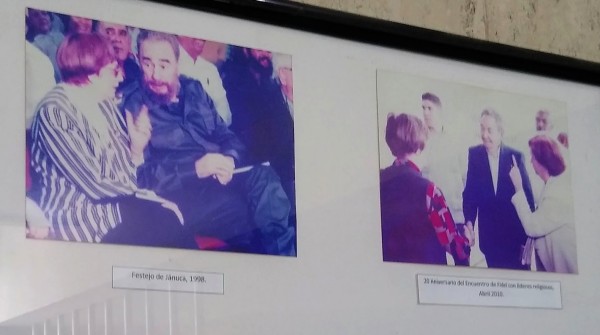
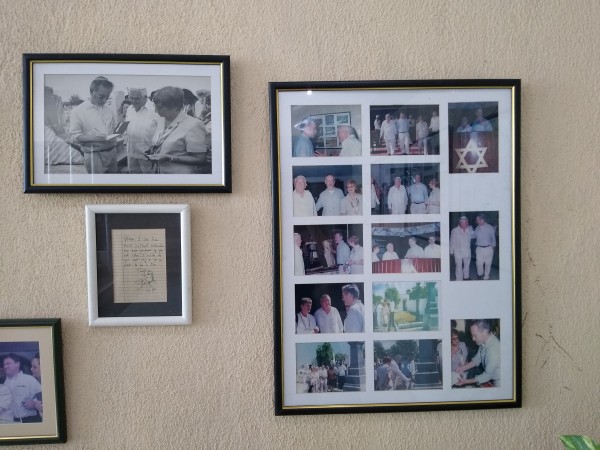
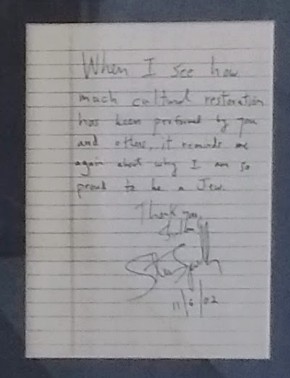
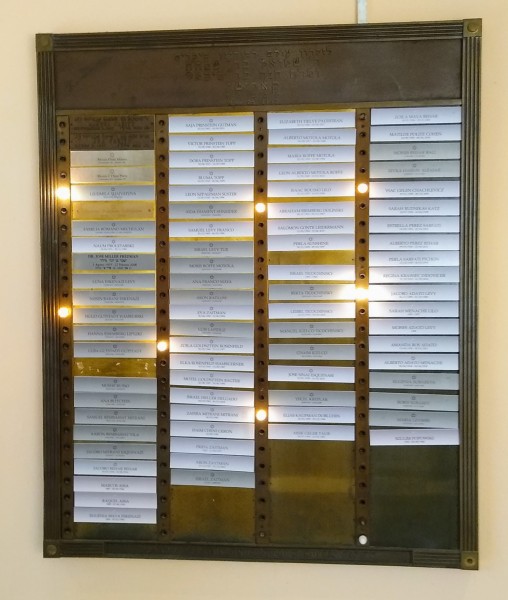
St. Thomas, USVI - December 2019
The Hebrew Congregation of St. Thomas
I visited this synagogue only a week after my visit to Havana, when I was on a cruise ship stop in St. Thomas. I walked from the cruise ship port, through the main part of town and up to the hill to the synagogue, where I got to attend a short presentation and then was allowed to tour the building and of course visit their gift shop. I was so moved by this visit, that I'm now a chai member of this community and have had the chance to attend several services online during the pandemic.
This synaogue is noteworthy for being the 2nd oldest synagogue in the United States (founded as a congregation in 1796, with the current building being built in 1833). It has a thriving local community (affiliated with the Reform movement) but depends on overseas visitors (and their donations) to keep their historic building maintained and operational.
Several elements of their building are worth noting, including their use of sand on the floor (some say this goes back to the days of persecution in Spain, when sand was place on the floors of secret shuls to help cover the sound of loud feet), their beautiful Torah scrolls (including at least one that was rescued from the Holocaust), and the different arrangement of the worship space (with the speakers stand being away from and facing the Ark for the Torah scrolls --- I don't remember if they referred to this as a Bimah or not, and the fact the building is largely open to the air and un-air conditioned.

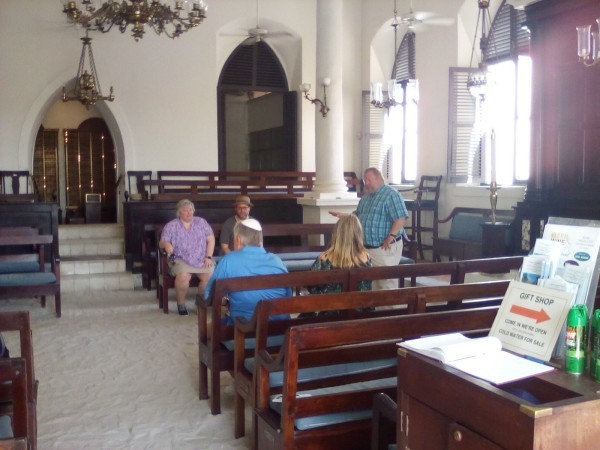
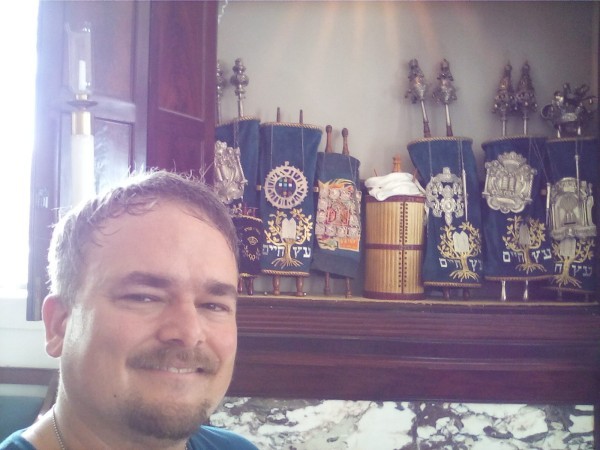

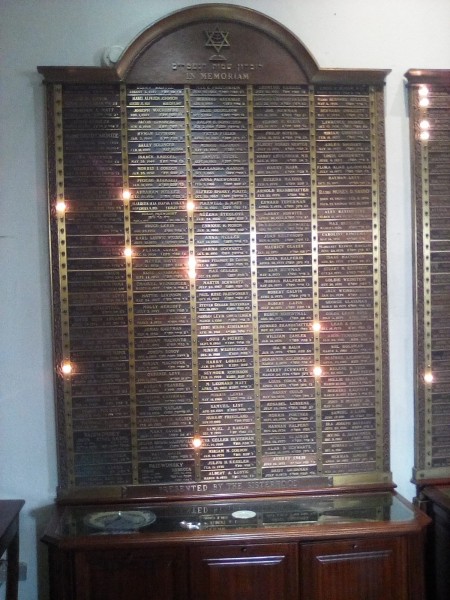
Temple Aaron, Trinidad, Colorado - March 2021
I got to visit the outside of this synagogue in March 2021 when I drove to Trinidad to catch a train to Barstow, California. Unfortunately due to the pandemic, I was unable to tour the inside, but I have since learned that this historic synaogue was on the verge of closing, but due to public support the congregation is functioning again in a hybrid form as both a historic site and a living congregation. Much like the St. Thomas synaogue, Aaron Synagogue will likely depend on the generosity of travelers and other outside donors to keep the doors open.
According to wikipedia, Temple Aaron is the oldest continually-operating synagogue in Colorado and the Mountain West.
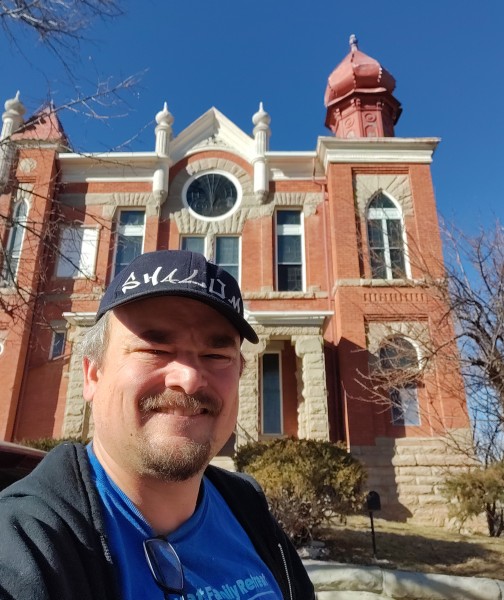
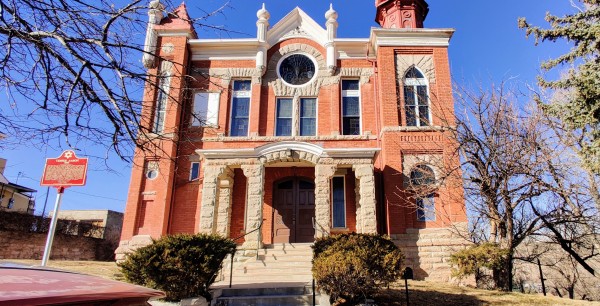
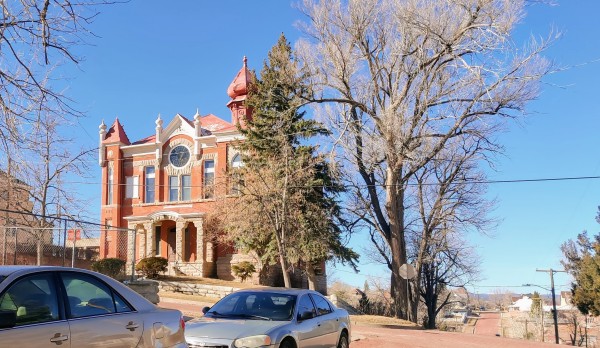
Thursday, February 3, 2022
2:27 pm
I didn't go to art school, but I hung out with a lot of art majors, so this world seems pretty familiar to me.
Frankly, the late 90's up unitl 9-11 was a pretty awesome time culturally, at least in some ways (not so great when it comes homophobia and racism, of course), so these pictures from the 90sArtSchool instagram make me rather nostalgic.
Unfortunately you can't go back in time, because even the dream of 90's has died in Portland.
9:50 am
SoJo.net Why my church isn't dropping our online service - by Melissa Florer-Bixler (Feb. 2, 2022)
I blogged about this a few days ago (in response to a NYT op-ed by Tish Harrison Warren), but I really like what Pastor Florer-Bixler has said in her piece, particularly these parts:
I’m grateful that Jane, the oldest member of our church, can join us even though getting out and about is difficult for her right now. Her daughter and son-in-law join her from the same Zoom screen. Wallace, who is blind and getting along in years, now joins us every week. For years he would faithfully read the bulletin through his adaptive software and listen to my sermons. Now Wallace can share prayer concerns, sing along with the hymns, and participate in our litanies. Other people in our church — including those struggling with paralyzing depression or haunted by anxiety from a previous church trauma — can muster just enough strength to join us on Zoom.
. . . I have also worried that hybrid church might discourage people from showing up as they are — in pajamas, with depression, frazzled, and late. I didn’t want a Zoom option to lead people to think that their bodies weren’t welcome in church unless they had it together. I remember multiple Sundays when I unloaded my children from the van into the church parking lot only to discover at least one didn’t have a pair of shoes. Into church we went. There was a grace to that messy discombobulation.
It turns out my fears were unwarranted. Instead, Zoom church helped us make more space to tenderly hold the wounds and gifts of our lives. Now we welcome the fullness of Wallace and we can keep an infant child and her mother safe during a pandemic. Now they are here with us. We are remembered to one another. In the presence of people separated from in-person worship, I have come to see Zoom church as its own sacrament, the heartache of separation present with us as we work to find the good news with the bodies we have.
This description of online community at Raleigh Mennonite Church reminds me of the joys I've experienced over the last two years of mostly online participation in religous community - mostly through Temple B'nai Israel of Oklahoma City, but also in times of connection with other communities: Spinoza Havurah, Joy Mennonite Church, Central Synagogue in NYC, the Objector Church (religious humanist). These experiences have kept me connected with others and engaged, and I believe that I've grown in my spirituality during these times, thanks to the "virtual option."
So, to close this blog post, I want to say THANK YOU! Thank you to all of the religious communities that are doing the hard work of putting together quality programming to share online, to communities that are brave enough to let their ordinary members take a bigger role in planning programming, to those who had to learn how to use zoom and how to improve their A/V setup. This hard work is sometimes not appreciated by all, so I think it is incredibly important that all folks who value these opportunities speak up to say thank you, but also to find ways to support these efforts, including financially.
Wednesday, February 2, 2022
11:29 pm
ComicBook.com: Top 10 King of the Hill Episodes Ranked - by Nick Valdez (Feb. 2, 2022)
I'm not normally a fan of list-based web content, but I'm making an exception for this list.
Several of the episodes chosen by this author would make my cut (especially - Flush with Power, the Hillennium, An officer and a gentle boy, and to Sirloin with Love), but there are several that I think should have made the cut but didn't, including:
- Returning Japanese - a two-part special where Cotton (Hank's war veteran shinless dad) goes to Japan for some kind of reconciliation ceremony (but with secret plan to spit on the Emperoror), Hank and Bobby come along for the trip and adventures ensure including Hank meeting his previously unknown Japanese half-brother, Bobbye falling for a cute girl at the dance arcade thing, and Cotton finally realizing that he was wrong about a few things.
- Death and Texas - this is the episode in which Peggy gets tricked into smuggling drugs into a prison through the game of boggle
- Aisle 8A - This is one of the classic episodes where Hank gets himself into a really awkward situation but by the end of the episode actually grows through the experience.
- Ho Yeah! - an outrageous episode, made memorable by the guest starring of Snoop Dogg as the voice of the character of "Alabaster Jones from the OKC" and Renee Zellweger as the voice of Tammy Duvall.
7:38 pm
This should be a great Shabbat morning!
Speaking of this event, I should mention that I've recently been getting more involved with The Spinoza Havurah and I'm really liking it a lot.
It's an online-only Humanistic Jewish community, with participants from several countries. We have very engaging services with non-theistic liturgy, but the feel of them is more "spiritual" (for lack of a better word) than some of the other humanistic services that I've experienced.
For me, it's not a replacement for my in-person Jewish community (a wonderfully inclusive Reform temple here in OKC) but the havurah is a wonderful supplement to that experience and a great way to connect with like-minded Jews in other locales. But for others, it is their primary Jewish home and I think is serving a critical need.
On a sidenote --- this works well because my Reform congregation follows the Reform norm of having their most important service on Friday night (which 100+ years ago was a "wild" innovation, created to enable Jewish shopkeepers and factory workers to attend services at the end of their workday), while the humanistic Havurah does their main service on Saturday morning (the more traditional time for a service outside of the Reform movement).
It is amusing to me how much "tradition" bends and changes over time.
3:15 pm
“The NFL more than any other league has tied branding to the U.S. military,” Samantha King, a cultural studies scholar at Queen’s University in Ontario, told me by phone last week. “It’s completely predictable.”
. . . King, who in 2008 wrote a paper on the sports-military nexus — “Offensive Lines: Sport-State Synergy in an Era of Perpetual War” — pointed out that Washington’s new name choice is “completely out of touch, given the reckoning the league did with Black Lives Matter and the link to the militarized policing.”
Indeed, it’s no less incongruous than emblazoning end zones and helmets with slogans championing racial equity while the hiring of league coaches and executives is so unfair that recently fired Black head coach Brian Flores on Tuesday sued the league and its teams, alleging racial discrimination.
It shouldn’t be forgotten that the Washington franchise finally adopted a new name, after 87 years, only under economic threat. That echoed the team’s historically stubborn refusal to move forward with society. After all, it took an ultimatum from the federal government in the early 1960s for the team to integrate — the last club in the league to do so.
“You’re not even moving from racism to militarism,” King said. “They’re connected.”
She wasn’t referring to the federal 1033 program that allows police departments across the country to procure used U.S. military weaponry, which we witnessed turned against U.S. citizens protesting the police killing of Michael Brown in Ferguson, Mo., and at other demonstrations. She was talking of the history of the U.S. military annihilating the very people the Washington team long dishonored by reducing them to mere logos on a helmet, while encouraging fans to mock them by painting their faces in a version of blackface and by defiling their religious dress as game-day attire.
10:18 am
InsideHook.com: Why the Internet Is Still Powered by a Great Big Fiber Optic Network Under the Sea : The world's communications rely on 745,000 miles of physical cabling on the ocean floor. Is that a massive vulnerability? - by Josh Sims (Feb. 1, 2022)
Fascinating story, but also worrisome...
But the expense is why cables are invariably operated by complex consortia or, more and more so, by mega-rich tech giants the likes of Google and Microsoft. In fact, with Amazon and Facebook, these companies are not only driving a boom in cable-laying (more cable was laid in 2018 than altogether in the previously two decades), but actually own or lease some half of all undersea bandwidth. With whole economies dependent on information flow, in time that’s going to raise interesting questions about national sovereignty. No wonder that, in the interests of national security, three years ago Australia blocked the Chinese company Huawei from installing a cable linking Australia to the Solomon Islands, choosing to fund the Coral Sea Cable System itself.
I can't help but worry about what the future of the internet will look like. I fear that it will be even more dominated by corporate and governmental voices if they control the infrastructure. I continue to think that we (as ordinary people) need to be preparing for the days when we might need to build our own ad hoc/decentralized internet.



